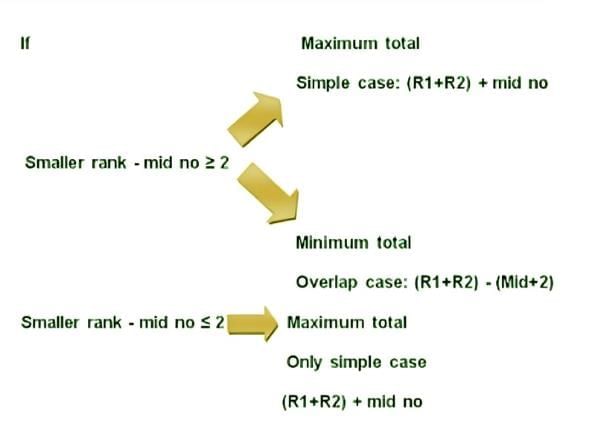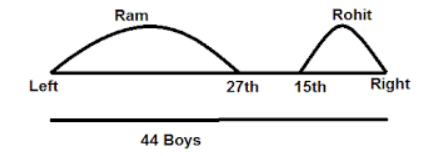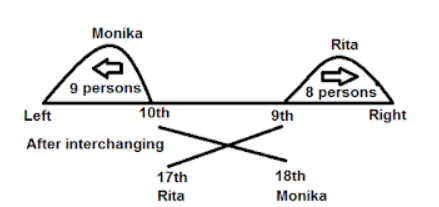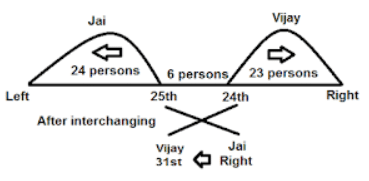Order and Ranking Important Notes | General Aptitude for GATE - Mechanical Engineering PDF Download
Order and Ranking
Order and ranking problems involve determining the positions or ranks of persons or objects in a line, row, or queue, often from both ends (left/right or top/bottom). These problems may also require finding total number of persons, positions after interchanges, or number of persons between two positions.
The questions can be categorised into several types:
- The total number of persons and the position of one person (either from left or right) are given.
- Positions of more than one person are given
- Overlapping conditions:
a. Overlapping case: When (left + right) positions > Total number of students
b. Not overlapping case: When the Total number of students > (left +right) positions - Ascending/Descending Order according to age, height, marks, etc.
We have to find out:
- Position from the other side.
- Total number of persons.
- Number of persons in between.
- Minimum/maximum number of persons in the row.
- The number of persons on either side of a particular person.
Formulas for Order and Ranking
- Finding ranks either from left or from right: Total – (given rank – 1) = required rank
- Finding total numbers: When ranks of one person is given from both sides of the row.
Ranks of common person from both sides (R1 + R2) – 1 - Finding the total number of persons: (Misc. Case)
When ranks of two persons and the number of persons between these two persons are given.
(a) (R1 + R2) + number of middle persons
(b) (R1 + R2) - (number of middle persons +2)
NOTE: Apply condition (b) only for overlapping case. - Finding the number of persons who are sitting between any two persons:
(a) Simple case (when total is known): Total - (Rank from left + Rank from right)
(b) Overlapping case(Rank from left + Rank from right) - (Total + 2) - Finding Rank of middle person: (Quick Trick)
Step 1: Convert both ranks from the same side (side from which rank of exactly mid is asked)
Step 2: Find the average of both ranks (answer) - Shortcut for calculating the total number of maximum and minimum persons in a row:

Note: Mid no. means the number of the middle person.
Solved Examples
Example 1: In a queue, Vijay is fourteenth from the front and Jack is seventeenth from the end, while Mary is exactly at the middle of Vijay and Jack. If Vijay be ahead of Jack and there be 48 persons in the queue, how many persons are there between Vijay and Mary?
(a) 5
(b) 6
(c) 7
(d) 8
(e) None of these
Ans: (d)
Explanation: Number of persons between Vijay and Jack = 48 – (14 + 17) = 17.
Now, Mary lies in middle of these 17 persons, i.e., at the ninth position.
So, number of persons between Vijay and Mary = 8.
Example 2: Kunal ranked sixteenth from the top and twenty-ninth from the bottom among those who passed an examination. Six boys did not participate in the competition, and five failed in it. How many boys were there in the class?
(a) 35
(b) 45
(c) 50
(d) 55
(e) None of these
Ans: (d)
Explanation: Total students who passed = 16 + 29 – 1 = 44
Total boys in class = Passed + Failed + Not participated= 44 + 5 + 6 = 55
Example 3: In a queue of children, Ajay is fifth from the left and Sunil is sixth from the right. When they interchange their places among themselves, Ajay becomes thirteenth from the left. Then, what will be Sunil's position from the right?
(a) 8th
(b) 14th
(c) 15th
(d) 16th
(e) None of these
Ans: (b)
Explanation: Since Ajay and Sunil interchange places, so Ajay’s new position (13th from left) is the same as Sunil’s earlier position (6th from right).
So, number of children in the queue = (13 + 6 -1) = 18.
Now, Sunil’s new position is the same as Ajay's earlier position, fifth from left.
Therefore, Sunil’s position from the right = (18 - 5+1 ) = 14th.
Example 4: Students line up in a queue in which Aman stands fifteenth from the left and Simran is seventh from the right. If they interchange their places, Simran would be fifteenth from the right. How many students are there in the queue?
(a) 21
(b) 22
(c) 28
(d) 29
(e) None of these
Ans: (d)
Explanation: Simran’s new position is 15th from the right as well as the left end of the row.
Therefore number of students in the queue = (14 + 1 + 14) = 29.
Example 5: Ram is in 27th place from left end in the row of 44 boys. Rohit is 15th from the right end in the same row .How many boys are there between them in the row?
(a) Eleven
(b) Ten
(c) Six
(d) Two
(e) None of these
Ans: (d)
Explanation: 
Total boys between them = 44 - (27 + 15) = 2.
Example 6: In a row of girls, Rita and Monika occupy the ninth place from the right end and tenth place from the left end, respectively. If they interchange their places, then Rita and Monika occupy seventeenth place from the right and eighteenth place from the left, respectively. How many girls are there in the row?
(a) 25
(b) 26
(c) 27
(d) Data inadequate
(e) None of these
Ans: (b)
Explanation:
 Total girls in the row = 17 + 9 = 26.
Total girls in the row = 17 + 9 = 26.
Example 7: Jai is 25th from left and Vijay is 24th from right. When they interchange their positions respectively then Vijay becomes 31st from right end. What will be Jai's position from left after interchanging?
(a) 25
(b) 26
(c) 27
(d) 28
(e) None of these
Ans: (e)
Explanation:
Jai's position from the left after interchanging = 25 + 6 + 1 = 32
Example 8: Zombo correctly remembers that his father's birthday is before 29th July but after 24th July whereas his younger brother correctly remembers that their father's birthday is after 23rd July but before 28th July and his elder brother correctly remembers that their father's birthday is on an odd date. On which date of July is definitely their father's birthday?
(a) Twenty-five or Twenty-seven
(b) Twenty-seven
(c) Twenty-five
(d) Twenty-six
(e) None of these
Ans: (a)
Explanation:
Example 9: Among Zojo, Yo, Xe, William and Vicky each scoring different marks in a test. Xe scored more than William but not as much as Vicky. Vicky scored more than Zojo, who scored less than Yo. Who scored second highest marks?
(a) Yo
(b) Zojo
(c) Xe
(d) Data inadequate
(e) None of these
Ans: (d)
Explanation:Order is Vicky > Yo/Zojo > Xe > William, but Yo and Zojo’s order is unclear.
Example 10: In a row of 40 girls, when Komal was shifted to her left by 4 places, her number from the left end of the row became 10. What was the place of Swati from the right end of the row if Swati was three places to the right of Komal’s original position?
(a) 22
(b) 23
(c) 25
(d) 26
(e) None of these
Ans: (e)
Explanation: On shifting 4 places to the left, Komal becomes 10th from the left end of the row. Thus, Komal’s original position was 14th from the left end.
Swati is 3 places to the right of Komal’s original position.
Clearly, Swati is 17th from the left end.
Number of girls to the right of Swati = (40 – 17) = 23.
Thus, Swati is 24th from the right end of the row.
|
193 videos|169 docs|152 tests
|
FAQs on Order and Ranking Important Notes - General Aptitude for GATE - Mechanical Engineering
| 1. What are the common formulas used for solving order and ranking problems in bank exams? |  |
| 2. How can the concept of order and ranking be applied in bank exams? |  |
| 3. How can one improve their skills in solving order and ranking problems for bank exams? |  |
| 4. What are some common mistakes to avoid while solving order and ranking problems in bank exams? |  |
| 5. How can order and ranking problems be tackled efficiently in bank exams? |  |

















